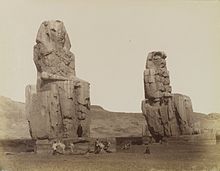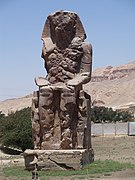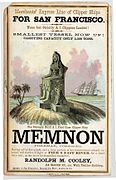About Colossi of Memnon
The Colossi of Memnon (Arabic: el-Colossat or es-Salamat) are two massive stone statues of the Pharaoh Amenhotep III. Fortunately, they stand at the front of the ruined Mortuary Temple of Amenhotep III They are the largest temple in the Theban Necropolis. Surprisingly, They have stood since 1350 BC. Significantly, They are well known to ancient Greeks and Romans, as well as early modern travelers and Egyptologists. Firstly, the statues contain 107 Roman-era inscriptions in Greek and Latin, dated to between AD 20 and 250; many of these inscriptions on the northernmost statue make reference to the Greek mythological king Memnon, whom the statue was then – erroneously – thought to represent.
Description
The twin statues depict Amenhotep III (fl. 14th century BC) in a seated position, his hands resting on his knees and his gaze facing eastwards (actually ESE in modern bearings) towards the river. Secondly, two shorter figures are carved into the front throne alongside his legs: these are his wife Tiye and mother Mutemwiya. In Addition, the side panels depict the Nile god Hapi.

People made the statues from blocks of quartizte sandstone which was quarried at el Gabal el Ahmar (near modern-day Cairo) . And transported them 675 km (420 mi) overland to Thebes (Luxor). The stones are too heavy for people to transport upstream on the Nile. The blocks used by later Roman engineers to reconstruct the northern colossus may have come from Edfu (north of Aswan). Including the stone platforms on which they stand – themselves about 4 m (13 ft) – the colossi reach 18 m (60 ft) in height and weigh an estimated 720 tons each. The two figures are about 15 m (50 ft) apart.
Modern images
-
The colossi of Memnon
-
West (or south) colossus
-
East (or north) colossus
-
sailing card for the clipper ship Memnon








Comment (0)